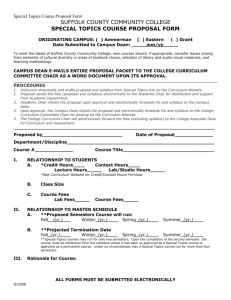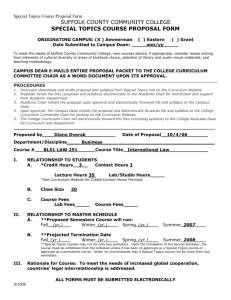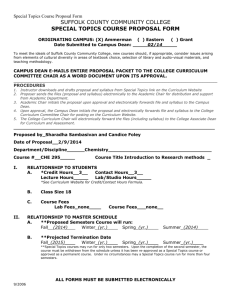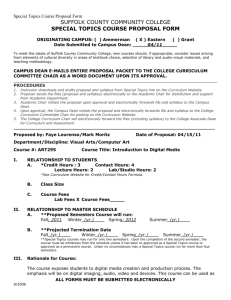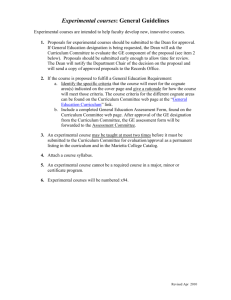Sports Economics - New Page - Suffolk County Community College
advertisement
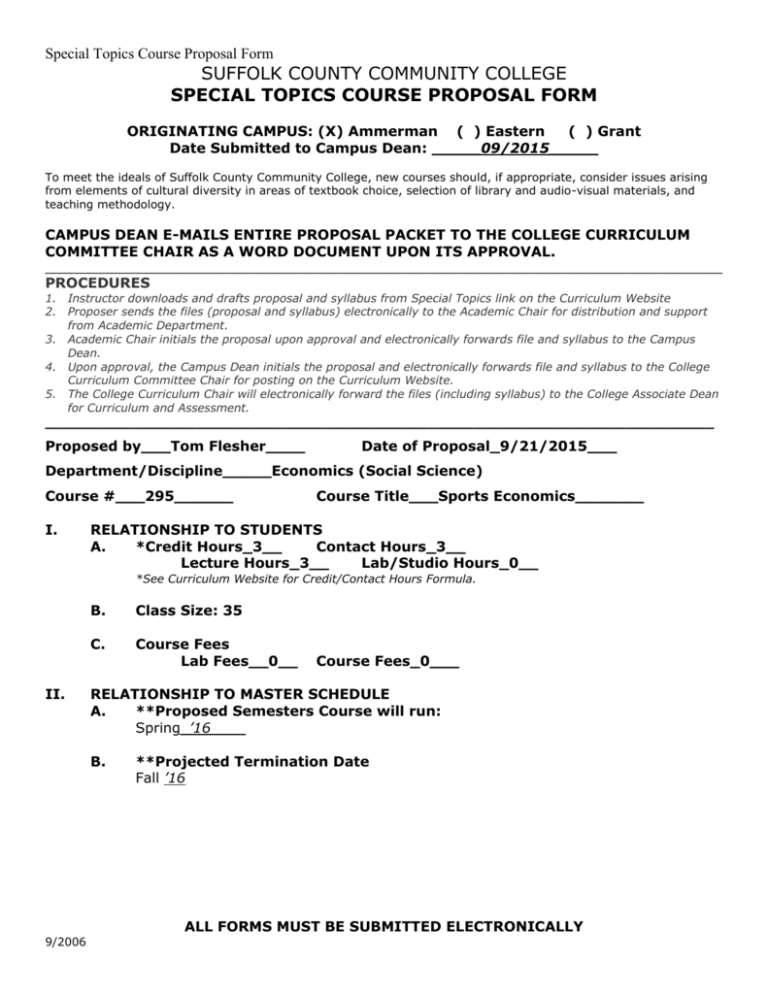
Special Topics Course Proposal Form SUFFOLK COUNTY COMMUNITY COLLEGE SPECIAL TOPICS COURSE PROPOSAL FORM ORIGINATING CAMPUS: (X) Ammerman ( ) Eastern ( ) Grant Date Submitted to Campus Dean: _____09/2015_____ To meet the ideals of Suffolk County Community College, new courses should, if appropriate, consider issues arising from elements of cultural diversity in areas of textbook choice, selection of library and audio-visual materials, and teaching methodology. CAMPUS DEAN E-MAILS ENTIRE PROPOSAL PACKET TO THE COLLEGE CURRICULUM COMMITTEE CHAIR AS A WORD DOCUMENT UPON ITS APPROVAL. ____________________________________________________________________________________________________________ PROCEDURES 1. Instructor downloads and drafts proposal and syllabus from Special Topics link on the Curriculum Website 2. Proposer sends the files (proposal and syllabus) electronically to the Academic Chair for distribution and support from Academic Department. 3. Academic Chair initials the proposal upon approval and electronically forwards file and syllabus to the Campus Dean. 4. Upon approval, the Campus Dean initials the proposal and electronically forwards file and syllabus to the College Curriculum Committee Chair for posting on the Curriculum Website. 5. The College Curriculum Chair will electronically forward the files (including syllabus) to the College Associate Dean for Curriculum and Assessment. ___________________________________________________________________________ Proposed by___Tom Flesher____ Date of Proposal_9/21/2015___ Department/Discipline_____Economics (Social Science) Course #___295______ I. Course Title___Sports Economics_______ RELATIONSHIP TO STUDENTS A. *Credit Hours_3__ Contact Hours_3__ Lecture Hours_3__ Lab/Studio Hours_0__ *See Curriculum Website for Credit/Contact Hours Formula. II. B. Class Size: 35 C. Course Fees Lab Fees__0__ Course Fees_0___ RELATIONSHIP TO MASTER SCHEDULE A. **Proposed Semesters Course will run: Spring_’16____ B. **Projected Termination Date Fall ’16 ALL FORMS MUST BE SUBMITTED ELECTRONICALLY 9/2006 Special Topics Course Proposal Form III. Rationale for Course: The economic way of thinking, cited in so many of our core learning outcomes, is nowhere better applied than in the world of sports. Many different opportunities to evaluate rational decisionmaking exist, from the free agency markets (where teams must convert productivity into financial value), to the existence of minimum wages for players with minimal experience (which can be addressed using a monopsony model not currently taught in Suffolk courses), to the application of labor market issues and public finance in stadiums. These applications and extensions of core economics ideas can be gathered under the umbrella of sports economics. The success of the US Women’s National Team in the Women’s Soccer World Cup, the public finance debate surrounding the successful Beijing 2022 Winter Olympics bid, the historic success of the 2015 New York Mets, and the recent legal controversy surrounding the NCAA and student-athlete unionization provide a backdrop that will generate interest. IV. Description of Course: Microeconomic issues will be discussed and expanded on in the context of sports, highlighting issues including labor markets, industrial organization, and price theory. V. Approvals Department Approval Judith Travers Date September 28, 2015 Academic Chair Campus Dean Approval_____________ Date_______________ Campus Dean ALL FORMS MUST BE SUBMITTED ELECTRONICALLY 9/2006 Special Topics Course Proposal Form SPECIAL TOPICS • COURSE SYLLABUS I. Course Number and Title: ECO 295, Sports Economics II. Description of Course: Microeconomic issues will be discussed and expanded on in the context of sports, highlighting issues including labor markets, industrial organization, and price theory. III. Course Objectives: (What should students learn as a result of taking this course and how will they demonstrate that learning?) Upon completion of this course students will: 1. Recognize the relationship between productivity and value 2. Understand and describe the special features of the labor market in sports, including monopoly and antitrust issues such as Major League Baseball and the National Collegiate Athletics Association 3. Use public finance concepts to evaluate proposals for public subsidies for sports teams 4. Demonstrate an understanding of rational choice through the lens of coaching/managing strategy choices and player tactics 5. Create visualizations of data to demonstrate abstract statistical relationships 6. Demonstrate an understanding of core statistical methods and apply them to one of the above learning outcomes IV. Required Texts and Materials: (List textbooks, newspapers, journals, Internet resources, CD-ROMS, Videos, other teaching materials to be used in the course.) Sports Economics by Rodney Fort; timely news articles as appropriate. V. Assessment of Student Learning: (Describe assessment measures, i.e., instruments that measure the attainment of course objectives.) Exams will use constructed-response (i.e. modeling) questions; homework will be assigned regularly using similar questions to generate feedback and assess learning. Exercises in class will use Excel or other simple statistical software to teach data visualization. A statistical project evaluating data using publicly-available databases (e.g. Sports Reference pages) will fulfill the department’s writing requirement and students will present findings, including a data visualization of the main finding. ALL FORMS MUST BE SUBMITTED ELECTRONICALLY 9/2006 Special Topics Course Proposal Form VI. Weekly Outline of Topics and Assignments: 1. Introduction to Sports Economics 2. Statistical Methods 3. Demand and Revenue 4. Broadcast Rights 5. Cost, Profit, and Wins 6. Market Outcomes 7. Case study on contract negotiations (utilizing topics 5 and 6), Exam 1 8. Player Compensation 9. Labor Relations 10.Subsidies 11.Fort, “The Stadium Mess” 12.Taxes, Antitrust, and Competition Policy 13.The NCAA 14.Can we use NCAA statistics to predict pro performance?, Exam 2 (noncomprehensive) 15.Paper Presentations ALL FORMS MUST BE SUBMITTED ELECTRONICALLY 9/2006
